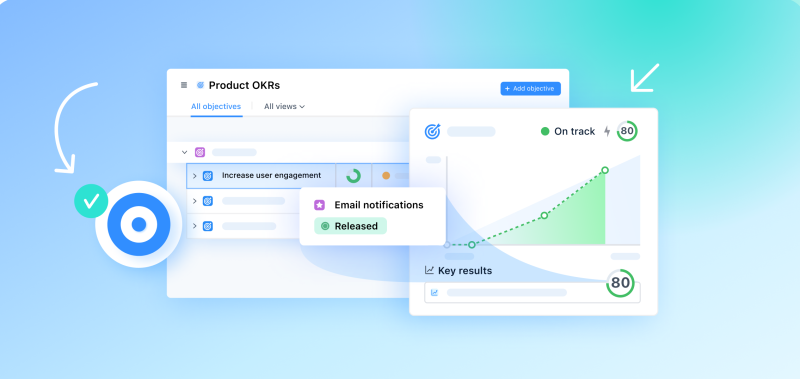2024 Enterprise OKRs: A Strategic Guide for Effective Planning

In the landscape of enterprise product management, strategic planning plays a pivotal role in steering organizations toward success. As we approach the dawn of 2024, companies are gearing up to define their objectives and key results (OKRs) to navigate the challenges that lie ahead. This article discussed the importance of strategic planning, the significance of OKRs in aligning with the company's vision, and the anticipated challenges in enterprise product management for the upcoming year.
In the context of enterprise product management, OKRs help streamline efforts toward the development, launch, and enhancement of products that resonate with customer needs. As companies gear up for 2024, the strategic alignment facilitated by OKRs becomes paramount.
Understanding OKRs in the enterprise context
In the enterprise context, OKRs serve as a powerful tool to bridge the gap between high-level organizational goals and the day-to-day efforts of individual teams and employees. This alignment is crucial for creating a cohesive and focused approach to achieving overarching business objectives.
Current trends affecting OKRs as we move towards 2024
As we approach 2024, several trends are shaping the landscape of OKR implementation in enterprises:
Focus on employee well-being and engagement: Companies are incorporating OKRs that prioritize employee satisfaction, mental health, and professional development.
Rise of remote work: Enterprises are adapting by incorporating OKRs that account for distributed teams, emphasizing collaboration tools, and measuring outcomes rather than traditional input-based metrics.
Incorporating sustainability objectives: Sustainability is no longer a peripheral concern but a central focus for many enterprises. OKRs are reflecting this shift, with companies setting objectives related to environmental, social, and governance (ESG) criteria.
Qualitative metrics alongside quantitative measures: Enterprises are now integrating customer satisfaction scores, employee feedback, and other qualitative indicators into their OKR frameworks to ensure a well-rounded assessment of performance.
Increased emphasis on learning and innovation: Continuous learning and innovation have become strategic imperatives for enterprises looking to stay competitive. OKRs are being leveraged to foster a culture of experimentation and learning.

The role of product management software in OKR planning
The utilization of technology has become indispensable. Among the array of tools available, airfocus, with its innovative Objectives app, emerges as a valuable asset in streamlining the complex process of OKR planning.
Centralizing objectives and key results: One of the primary challenges in OKR planning is ensuring that every team member is aligned with organizational objectives.
Facilitating collaboration: OKR planning involves collaboration across various departments and teams. The airfocus Objectives app serves as a collaborative hub, allowing teams to work seamlessly on defining, refining, and aligning their objectives.
Real-time progress tracking: The ability to provide real-time visibility into the progress of OKRs is invaluable for organizations seeking to stay agile and responsive in the face of changing circumstances.
Prioritizing objectives: OKR planning often involves a multitude of objectives, each vying for attention and resources. Prioritization is very important to enable organizations to focus on the most impactful objectives.
Enhancing flexibility: The dynamic nature of business requires flexibility in planning. airfocus' modularity accommodates this need by allowing organizations to adapt and iterate their OKRs as circumstances evolve.
User-friendly interface: The effectiveness of any software tool lies in its usability. airfocus boasts a user-friendly interface, making it accessible to teams with varying levels of technical expertise.

Building a resilient 2024 product roadmap with OKRs
As enterprises gear up for the challenges and opportunities of 2024, constructing a resilient product roadmap is crucial for success. Let's explore a step-by-step guide on setting strategic OKRs, ensuring flexibility, and delve into real-world examples that showcase the resilience of this approach.
How to ensure OKRs are flexible yet robust enough to withstand market changes
Here’re some techniques to ensure OKRs are flexible:
Embrace agile principles: Agile methodologies emphasize adaptability and responsiveness. Apply these principles to your OKR framework, allowing for quick adjustments to objectives and key results based on market shifts or emerging opportunities.
Continuous monitoring of market trends: Incorporate mechanisms for regular market analysis into your OKR check-ins, enabling the organization to respond proactively to changes.
Scenario planning: Anticipate potential scenarios and develop contingency plans. This foresight allows the organization to pivot quickly when needed without compromising the overall strategic direction outlined by the OKRs.
Feedback loops and learning culture: Foster a culture of continuous learning and feedback. Encourage teams to share insights, learnings, and challenges openly.

Aligning cross-functional teams around 2024 OKRs
As enterprises look to navigate the complexities of 2024, effective communication, collaboration, and accountability are paramount for ensuring that every team contributes cohesively towards organizational goals. Here's a closer look at strategies for communicating OKRs, tips for fostering collaboration, and insights into overcoming potential obstacles.
Strategies for communicating OKRs across departments
Clear and transparent communication: Clearly articulate the organizational objectives and how each department's OKRs contribute to these broader goals.
Town hall meetings and workshops: Conduct town hall meetings or workshops to unveil and discuss OKRs at the organizational level.
Visual representation: Utilize visual aids such as charts, diagrams, or interactive presentations to represent OKRs by simplifying complex information and make it more accessible to teams.
Cross-functional kick-off meetings: Host cross-functional kick-off meetings at the beginning of each OKR cycle.
Tips for fostering collaboration and accountability around OKRs
Form cross-functional teams and task forces: These groups can work together to achieve specific key results.
Regular check-ins and updates: Establish a routine of regular check-ins and updates to monitor progress on OKRs. These meetings provide an opportunity for teams to share accomplishments, discuss challenges, and offer support to one another.
Shared metrics and key performance indicators (KPIs): Align metrics and key performance indicators across departments to create a shared understanding of success.
Recognition and rewards: Implement a recognition and rewards system that acknowledges cross-functional collaboration.

Discuss potential obstacles and how to overcome them
Resistance to change: Address resistance by clearly communicating the rationale behind the OKRs and how they contribute to the organization's success.
Lack of clear communication: Implement regular communication channels, such as newsletters, intranet updates, or collaboration platforms, to keep everyone informed.
Competing priorities: Prioritize OKRs at the organizational level to ensure that all departments are aligned with the same overarching goals.
Inadequate resources: Conduct resource assessments during the OKR planning phase to identify potential gaps.
Measuring success: OKRs and performance metrics
A robust measurement strategy ensures that progress is not only monitored but also aligned with strategic objectives.
Setting quantifiable criteria for OKR success
Define each key result with specificity and clarity, ensuring that there is no ambiguity in what success looks like. Quantifiable criteria should be explicit, measurable, and tied directly to the accomplishment of the associated Objective. Before the commencement of the OKR cycle, establish baseline metrics for each key result. This provides a starting point against which progress can be measured and allows for a clear understanding of the distance to be covered.
Set time-bound targets for achieving key results. This temporal aspect not only adds urgency to the objectives but also facilitates a structured evaluation of performance within a specified timeframe. Conduct regular check-ins throughout the OKR cycle to assess progress. If the initial criteria seem overly ambitious or insufficient, be willing to make adjustments. Flexibility is essential for ensuring that the targets remain challenging yet achievable.
Introduce the concept of key performance indicators (KPIs) that complement OKRs
KPIs should be closely aligned with an organization's broader strategic objectives. While Objectives and Key Results (OKRs) offer a structured approach to achieve these objectives, KPIs provide a detailed perspective on specific performance metrics that contribute to the overall success of the organization.
A key aspect of effective KPI management is maintaining a balance between leading and lagging indicators. Leading indicators are proactive, giving insights into activities that will drive future success, whereas lagging indicators are reactive, assessing the outcomes of past activities. This balance provides a comprehensive understanding of performance.
It's also crucial that KPIs are both measurable and directly relevant to the organization's success. They should be concrete indicators that can be quantified and directly linked to the organization's goals and achievements. Moreover, regular monitoring and analysis of KPIs are imperative. This ongoing evaluation acts as an early warning system for the organization, enabling it to identify trends, make informed decisions, and adjust strategies if necessary. By consistently tracking these metrics, organizations can ensure they stay on track towards achieving their strategic objectives.

Adjusting OKRs mid-cycle
The ability to adapt and respond to changing circumstances is crucial. Adjusting Objectives and Key Results (OKRs) mid-cycle is a strategic necessity to ensure that organizations remain agile and focused on their overarching goals. This section explores when and how to revise OKRs and the crucial task of keeping teams aligned during these changes.
When and how to revise OKRs
Set specific periodic review points within the OKR cycle. These intervals provide natural opportunities to assess progress, evaluate the relevance of OKRs, and consider adjustments.
Revise OKRs in response to significant external factors that impact the business landscape.
Reevaluate OKRs if key assumptions or foundational elements on which the objectives are based undergo significant changes.
Encourage a culture of continuous learning and feedback. If teams identify that the initial assumptions or strategies are not yielding the expected results, it may be prudent to adjust OKRs mid-cycle.
Keeping teams aligned during changes
Here’re some methods to keep teams aligned:
Transparent communication: Communication is key during periods of adjustment. Clearly communicate the reasons behind the need for changes to OKRs.
Rearticulating the 'Why': Remind teams of the broader vision and explain how the adjustments contribute to the long-term success of the organization.
Inclusive decision-making: Involve teams in the decision-making process. Seek input and feedback when considering revisions to OKRs.
Adjusting team objectives in tandem: Ensure that changes to organizational-level OKRs are reflected in corresponding adjustments to team-level objectives.
Providing support and resources: Offer support and allocate resources as needed. Adjustments to OKRs may require shifts in priorities or additional resources.
Continuous feedback loop: Establish a continuous feedback loop throughout the adjustment process. Regular check-ins and updates provide opportunities for teams to share insights, address challenges, and receive guidance.

Conclusion
As we stand on the threshold of 2024, the significance of strategic planning and the integration of Objectives and Key Results (OKRs) into organizational frameworks cannot be overstated. The journey we've explored—from understanding the role of OKRs in enterprise settings to building resilient product roadmaps, aligning cross-functional teams, and measuring success—illuminates a path forward in the dynamic landscape of business.
As the business landscape continues to evolve, strategic planning with OKRs becomes not just a tool but a mindset—a compass guiding organizations toward resilience, adaptability, and success. We wish you a strategically sound and successful 2024.

Vishal Chaudhary

Read also






Create effective product strategy

Experience the new way of doing product management



